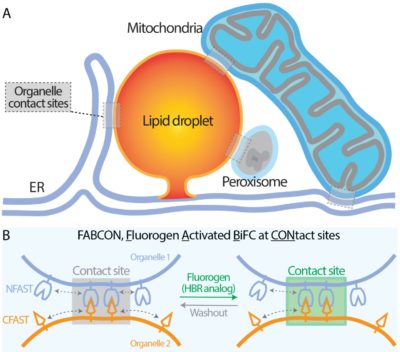Chi-Lun Chang of the St. Jude Children’s Hospital, Alison Tebo of HHMI’s Janelia campus, and team, have just disclosed lipid droplets equipped with splitFAST to enable lipid droplets interactions studies. Contact sites between lipid droplets and other organelles are essential for lipid and energy homeostasis. However, despite their importance and recent research endeavors, the dynamic regulation of lipid droplet-organelle contact sites remains poorly understood. Technical challenges in deciphering these nanoscale foci are indeed yet to be fixed.
During the past decade, proximity-induced reporters, such as split fluorescent proteins (FPs) or fluorescence resonance energy transfer (FRET) FP pairs, have been applied to probe organelle proximity at contact sites. Though excitingly promising, the implementation has encountered many roadblocks, e.g., irreversibility, fluorescence leakiness, and low signal-to-noise readout. The team has hence developed a full, versatile, toolkit, dubbed FABCON. FABCON is based on splitFAST of The Twinkle Factory as a fluorescent proximity reporter and on the protein anchor 6xHp, derived from Spastin’s Hp motif and specific to lipid droplets. They successfully implemented FABCON to reveal insights into the dynamic regulation of lipid droplet-organelle contact sites with endoplasmic reticulum, mitochondria, and peroxisomes.
Interestingly, the authors have implemented splitFAST2 (= splitFASTlow), the next-gen FAST complementation system further published in ACS Chem. Biol. 2024 by Prof. Gautier’s team. Prof. Gautier, together with Dr. Tebo, released the initial splitFAST, a breakthrough complementation reporter for protein−protein interaction (PPIs) based on the chemogenetic fluorescent FAST in 2019. Four years later, they disclosed splitFAST2, which displays higher brightness, lower self-complementation, and higher dynamic range. As a result, splitFAST2 allows higher spatial and temporal resolution, opening great prospects to decipher PPIs and empower cell-based assays for drug screening.
The Twinkle Factory supplies a whole range of fluorogenic reporters for splitFAST, varying in colors and affinity. Initially introduced with FAST and splitFAST, they work equally well with splitFAST2.
Stain different. Tag FAST!
More reading on splitFAST2
About FABCON: Li, X., Gamuyao, R., Wu, M. L., Cho, W. J., Kurtz, N. B., King, S. V., … & Chang, C. L. (2024). A fluorogenic complementation tool kit for interrogating lipid droplet-organelle interaction. J. Cell Biol. (2024) 223 (9): e202311126. (https://doi.org/10.1083/jcb.202311126)
About one other application of splitFAST2 in mammalian cells: Garcia Casas, P., Rossini, M., Pavenius, L., Saeed, M., Arnst, N., Sonda, S., … & Filadi, R. (2023). Simultaneous detection of membrane contact dynamics and associated Ca2+ signals by reversible chemogenetic reporters. bioRxiv, 2023-12 (https://doi.org/10.1101/2023.12.28.573515)
About splitFAST2 genesis: Rakotoarison, L. M., Tebo, A. G., Böken, D., Board, S., El Hajji, L., & Gautier, A. Improving Split Reporters of Protein–Protein Interactions through Orthology-Based Protein Engineering. ACS Chem. Biol. 2024


Recent Comments